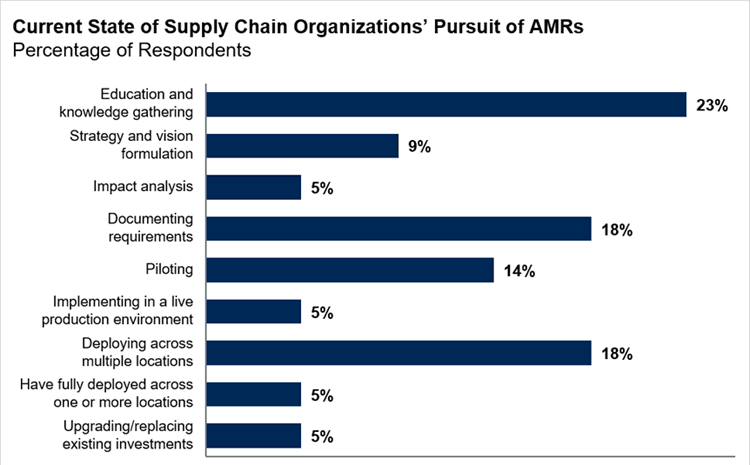Automated Mobile Robots (AMRs) are an attractive alternative to more traditional forms of material handling automation in distribution, says analyst Dwight Klappich of Garter.
In a recent research note, Klappich says AMRs are really extensions of Automaker Guided Vehicles (AGVs), which have been around for decades. AMRs add intelligence, guidance and sensory awareness to conventional AGVs, he adds, writing that "AMRs address the historic limitations of traditional AGVs, making them better suited to, and more cost-effective for, complex warehouses and collaborative activities."
Supply Chain Digest Says... |
|
|
AGVs have been most heavily adopted by far in manufacturing environments, especially automotive sector, and used primarily for static material moves from point A to point B. But a new generation of mobile robots is a addressing the weaknesses of AGVs for distribution, with new capabilities in three main areas, Klappich says:
• Navigation: Although the wires, tracks or floor tags required for most traditional AGV navigation do work, this rigid approach is too limiting in the long term, Klappich says. AMRs instead use a variety of techniques, like vision or laser systems, to self-navigate.
• Sensors: Klappich says AMRs are increasingly being outfitted with arrays of sensors, incluing multiple cameras, lasers, or motion or sound detectors. Such sensory awareness is a mandatory to maintain safety while moving around a DC.
• Intelligence: Klappich cites embedded analytics, artificial intelligence (AI) and the use of agent-based technologies that will enable the AMRs to navigate on their own, optimize work individually and across a group, and respond to unforeseen events, such as breakdowns or bottlenecks.
And Klappich is quite bullish on the future of AMRs in distribution, writing that "Next-generation smart AMRs will transform warehouse operations over the coming decades as they become truly more autonomous and intelligent. Costs and complexities will also come down, which will open the market to more companies."
How are AMRs actually being used in distribution? Klappich cites a common use case of an order picking process where the robot follows a person as he or she case picks, with the AMR autonomously navigating between aisles and to the shipping dock, taking much of the walking time away from the human associate in favor of robotic travel.
Without AMRs, a worker would load a pallet on a pallet jack, start at one end of the warehouse and walk nearly its entire length, from one end to the other, picking items for a single order, Klappich says. Often, associates walk seven to ten miles per day in these environments. As much as 30% or more of the travel time and distance is often unproductive.
But Klappich says with AMRs, an aisle picking process could be use in which where order picker stay in one or two aisles and the robots autonomously come to them. The users then pick the appropriate items from their aisle, and, once done in that aisle, the robot moves autonomously to the next aisle where picking is needed, or off to staging when the picks are complete.
Interest in mobile robots is early but developing. The graphic below from Gartner shows that most companies are gathering information or developing requirements – but 18% are deploying AMRs across multiple facilities.

Source: Gartner
Companies are increasing automation generally in distribution, driven by labor shortages, ecommerce requirements, and hopes to increase throughput from a given DC.
(See More Below)
|
CATEGORY SPONSOR: SOFTEON |
|
|
| |
|
|
In the right environments, conventional MHA systems can have strong value propositions, Klappich says, but notes that "these systems often have long times to value, high total costs of ownership, long payback periods and are not very adaptable."
Now, deployment of AMRs might provide a middle ground that offers productivity and throughput gains but at lower cost and risk and with greater flexibility than full automation.
With his bullish take on mobile robots, Klappich recommends companies analyze operations to see if there are areas where AMRs might provide value. That starts by "studying travel patterns in each facility, specifically looking for excess and wasted travel times, which is an easy target for AMRs."
And Klappich adds that companies should think out of the box in doing that analysis, looking not just for ways to improve current processes with AMRs but also looking for "possibly radical, new approaches."
As a caution, Klappich notes a barrier to AMR adoption will be the lack of talent to design, select, deploy and maintain mobile robot-based systems.
How fast do you believe mobile robots will be deployed in distribution? Do you see any downsides? Let us know your thoughts at the Feedback section below.
|